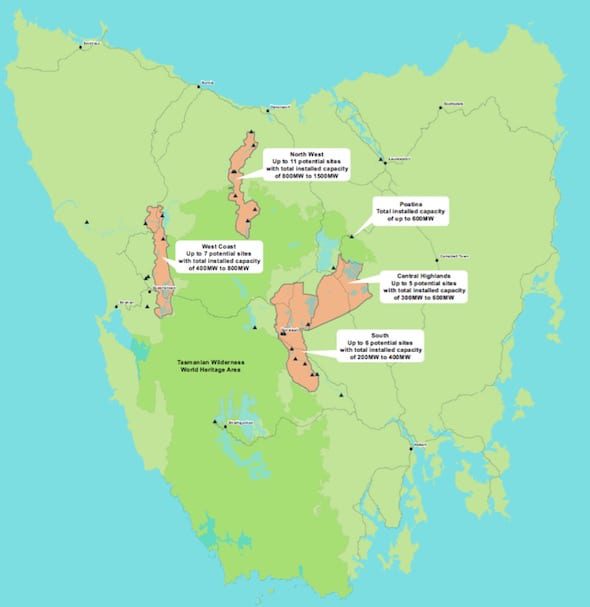The potential for Tasmania to double its renewable energy capacity and serve as the “battery of the nation” is set to be explored via two new feasibility studies, backed this week by the Australian Renewable Energy Agency.
ARENA said on Friday it has committed up to $2.5 million, an amount that will be matched by the state government-owned utility Hydro Tasmania, to explore the feasibility of expanding the state’s hydro power capacity and developing “significant” pumped hydro resources to store and dispatch renewable energy.
According to Hydro Tasmania, the company has identified 30 potential pumped hydro energy storage sites in four regional areas of the state – a list it hopes to trim to 10-15 via the feasibility study.
Once fully realised, the utility expects those 10-15 pumped hydro sites to generate up to 2,500MW of electricity, which would double Tasmania’s current hydro capacity and provide flexible, dispatchable energy when needed by customers – both in the state and on the mainland.
The development of the PHES sites also promises to create up to $5 billion of infrastructure investment in the island state, and up to 3,000 jobs across a 10 to 15 year construction period, Hydro Tasmania said.
“The Battery of the Nation is about energy security and affordable prices,” said Hydro Tasmania CEO Steve Davy on Friday. “Doubling Tasmania’s renewable energy capacity addresses three big challenges at once.
“It will lock in full energy security for Tasmania, help give Tasmanians some of the nation’s cheapest power prices, and give us plenty of spare energy to support mainland Australia.
“At a time when Australia badly needs flexible and storable energy to replace the coal power it’s phasing out, the Battery of the Nation offers a future that’s clean, reliable and affordable,” he said.
For ARENA, the feasibility studies are about further examining the role that pumped hydro energy storage can play in accelerating Australia’s transition to renewable energy.
“These feasibility studies are the first step towards significantly upgrading or replacing some of Tasmania’s existing power stations and introducing pumped hydro energy storage,” said ARENA CEO Ivor Frischknecht.
“With these projects, we could more than double Tasmania’s hydro capacity and power an additional 500,000 households. Tasmania could play a crucial role in helping to provide secure, reliable – and renewable – electricity for the National Energy Market,” he said.
The power stations slated for upgrade in the feasibility studies would include the Tarraleah Power Scheme and the Gordon Power Station, Hydro Tasmania said.
In the case of Tarraleah, an 80-plus years old power station in the Derwent Valley, a new power station would be built, at a cost of up to $650 million, increasing the energy output by up to 200GWh a year.
The redevelopment of the 432MW Gordon Power Station – Tasmania’s largest – would involve building a new turbine, to better manage water flows and allow more efficient generation.
The initial stages of these studies, jointly funded by ARENA and Hydro Tasmania at a cost of $1 million, are expected to be completed by the end of the year. Depending on the outcomes of the studies, construction on the Gordon Power Station augmentation could being as early as 2018.











